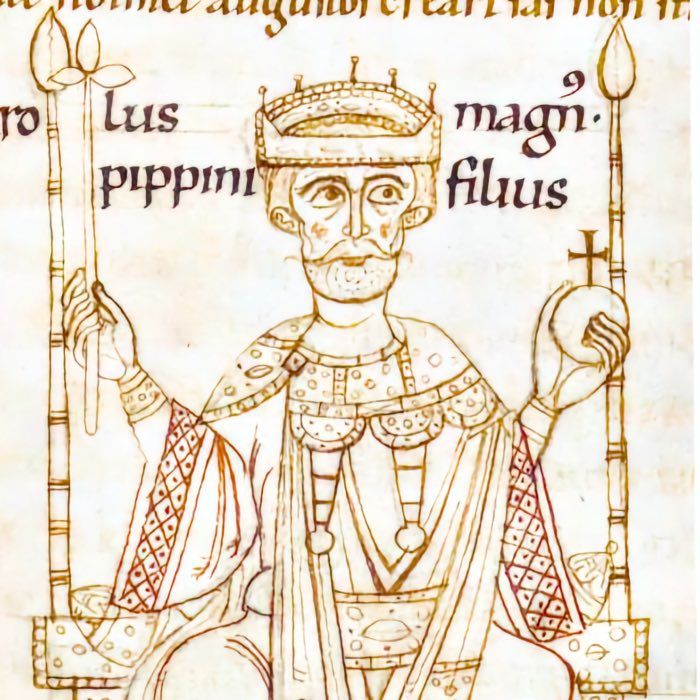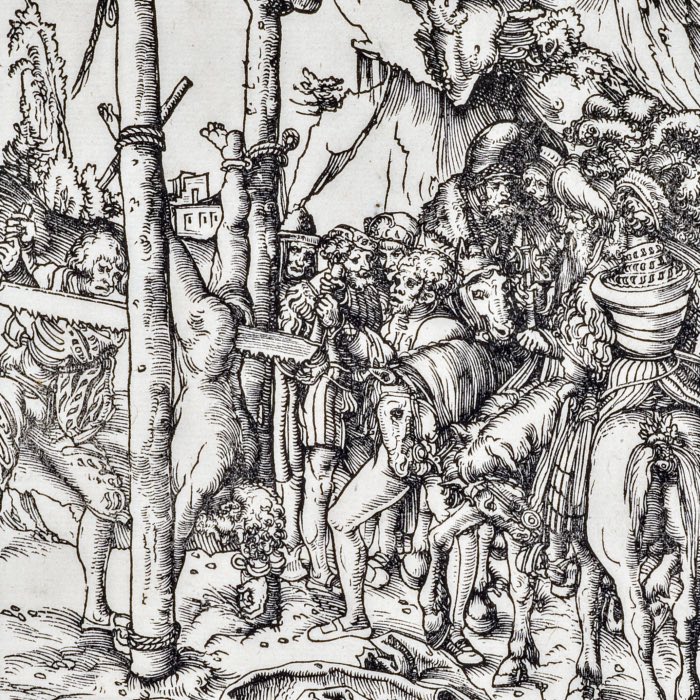The cynicism of Christian tree worship: A reflection on Christmas trees and the destruction of pagan cult objects
The Christmas tree, a beloved emblem of the Christian holiday season, has become a symbol of festivity, community, and faith. Today’s Christmas imagery includes other cherished symbols like the Christmas wreath and the Nativity scene, each carrying its own rich history and layers of meaning. However, the tradition of the Christmas tree is fraught with historical irony. This seemingly innocuous practice, now integral to Christian celebrations, stands in stark contrast to the violent missionary campaigns of early Christianity, during which sacred trees and other pagan cult objects were systematically destroyed. In this post, we briefly explore the paradoxical history of the Christmas tree.
 Traditional Christmas tree, interpreted and generate by DALL•E.
Traditional Christmas tree, interpreted and generate by DALL•E.
The history of the Christmas tree tradition
The Christmas tree tradition traces its origins to medieval and the early Renaissance era Central Europe, particularly Germany, Estonia, and Latvia.
With the emergence of mystery plays, liturgical dramas aimed to educate the masses about stories from the Bible, trees began to be used as props to represent the Tree of Paradise in the Garden of Eden. These trees were adorned with apples, symbolizing the forbidden fruit, reinforcing the narrative of humanity’s fall and the promise of redemption through Christ. They were often displayed during the Feast of Adam and Eve on December 24th. This practice, which originated in the 12th century, laid the foundation for the modern Christmas tree tradition. The use of evergreen trees, which remained green throughout the winter, holds another symbolic significance, representing God’s eternal nature.
 Adam and Eve and the Tree of Paradise, interpreted and generate by DALL•E.
Adam and Eve and the Tree of Paradise, interpreted and generate by DALL•E.
Fir trees have always played a symbolic role in various pre-Christian rituals in Europe. The Germanic Yule traditions, for example, involved bringing greenery indoors and decorating trees to honor deities associated with fertility and rebirth. Early Christians adapted these symbols to align with their faith, repurposing the evergreen as a sign of eternal life and Christ’s promise of salvation. Thus, the adaptation of evergreen trees into Christian festivities was both a theological reimagining and a pragmatic cultural synthesis, allowing the Church to incorporate familiar pagan symbols into its own spiritual narrative.
By the 16th century, the use of evergreen trees during Christmas had expanded beyond symbolic or liturgical contexts and began appearing in public spaces. One of the earliest written records of a Christmas tree in Germany dates to 1527 in Stockstadt am Main. Documentary evidence from 1539 further indicates that a Christmas tree was erected in Strasbourg Cathedral, likely as part of festive public displays.
In guild houses, evergreen trees became part of communal Christmas celebrations. The Brotherhood of Blackheads, a merchant guild active in the Baltic region, is known to have set up a decorated tree during Christmas in their guild houses in Tallinn (then Reval) and Riga as early as 1441. On the last evening of the festivities, the tree was brought to the town square, where members of the brotherhood danced around it.
 Guilds decorating a Christmas tree, interpreted and generate by DALL•E.
Guilds decorating a Christmas tree, interpreted and generate by DALL•E.
The practice of Christmas trees entering private homes is documented in Alsace in the early 17th century. A record from 1605 describes the custom in Strasbourg: “At Christmas time, Christmas trees are set up in the parlors in Strasbourg, with roses cut out of multi-colored paper, apples, wafers, slices of tinsel [thin, shaped tinsel plates made of metal], sugar, etc.” (“Auff Weihenachten richtett man Dannenbäum zu Straszburg in den stuben auff daran hencket man roszen ausz vielfarbigem papier geschnitten, Aepfel, Oblaten, Zischgolt [dünne, geformte Flitterplättchen aus Metall], Zucker etc.”). This description underscores the combination of symbolic and decorative elements that characterize early Christmas trees.
A widely repeated legend attributes the popularization of the Christmas tree to Martin Luther, who is said to have been inspired by a night sky filled with stars shining through the branches of an evergreen tree. However, this account is largely anecdotal, with little direct evidence to substantiate Luther’s personal involvement in the tradition.
The evolution of the Christmas tree tradition reflects a complex interplay of religious, cultural, and communal influences. Its adoption by Christians was not merely an act of invention but a synthesis of pre-existing customs and theological reinterpretations that allowed the Church to imbue the symbol with new meaning.
The destruction of pagan cult objects and sites
The rise of Christianity in Europe was marked by both non-violent missionary work and aggressive campaigns to obliterate pagan religions and their associated symbols. Sacred trees, groves, and other natural sites often held central importance in pre-Christian belief systems. These sites were seen as physical manifestations of divine power and were integral to the spiritual and communal lives of pagan societies.
 Pre-Christian tree adoration cults, interpreted and generate by DALL•E.
Pre-Christian tree adoration cults, interpreted and generate by DALL•E.
One infamous example of Christian zealotry is the destruction of the Donar Oak (also known as Thor’s Oak) in the 8th century. According to missionary accounts, the oak, sacred to the Germanic god Thor, was felled by Saint Boniface near Fritzlar (in present-day Germany). The act was a calculated demonstration of Christian supremacy, intended to undermine the spiritual foundation of the local pagan population. Boniface’s followers reportedly used the wood from the sacred tree to construct a church, symbolizing the victory of Christianity over paganism.
 Boniface destroying the Donar Oak, interpreted and generate by DALL•E.
Boniface destroying the Donar Oak, interpreted and generate by DALL•E.
Another instance of desecration occurred in the British Isles, where the sacred groves of the Druids were systematically destroyed during Christian missions. The Druids, who considered certain trees to be embodiments of divine power, were targeted as heretical practitioners. Sacred yews and oaks were burned or chopped down, their destruction often accompanied by the massacre of those who resisted conversion.
The brutality of early Christian missions
The process of Christianization contains many episodes of violence and coercion, reflecting the complex dynamics of religious conversion in medieval Europe. The Christianization of the Saxons under Charlemagne (8th–9th centuries) provides a grim example. Charlemagne’s campaigns were marked by brutal suppression of pagan practices. The Massacre of Verden in 782, during which Charlemagne ordered the execution of approximately 4,500 Saxons who had refused to convert, epitomizes the bloody reality of forced Christianization.
 Charlemagne slaughtering the Saxons, interpreted and generate by DALL•E.
Charlemagne slaughtering the Saxons, interpreted and generate by DALL•E.
In Scandinavia, the conversion process often involved the destruction of sacred sites and the execution of pagan leaders. Missionaries, supported by monarchs seeking to consolidate power, carried out campaigns of terror against local populations. For example, in Norway, King Olaf Tryggvason’s efforts to Christianize the population included the destruction of pagan temples and the torture or execution of those who resisted baptism. Such acts were intended to demonstrate the futility of clinging to pagan gods and to instill fear among those who might defy Christian authority.
The cynicism of co-opting pagan practices
The violent eradication of pagan sacred objects and sites starkly contrasts with Christianity’s later adoption of pagan symbols, such as the Christmas tree. This paradox reveals a pragmatic approach to religious conversion – destroying paganism’s spiritual infrastructure while appropriating its more palatable elements to ease the transition for new converts. By adopting the evergreen tree and repurposing it within a Christian context, the Church sought to neutralize its pagan associations and integrate it into its own religious framework.
 Christs worshipping a tree, interpreted and generate by DALL•E.
Christs worshipping a tree, interpreted and generate by DALL•E.
In my opinion, this adaptation can be seen as cynic to some extent. The Christmas tree’s pagan origins cannot be erased, and its continued use highlights the contradictions within Christian traditions. The reverence for a tree, once a symbol of pagan spirituality, now sits at the heart of a religion that sought to annihilate similar symbols. This contradiction undermines claims of moral and spiritual superiority that justified the violent suppression of paganism.
Conclusion
The historical narrative of Christianity’s rise in Europe is one of both destruction and assimilation. Sacred trees and groves, long regarded as symbols of life and divinity in non-Christian traditions, were systematically destroyed to make way for the spread of a monotheistic religion. Yet, paradoxically, elements of these very traditions were later repurposed and celebrated within the Christian faith. This selective approach to cultural heritage underscores the pragmatism – and the hypocrisy – of early Christian missionary efforts.
The next time we admire a beautifully decorated Christmas tree, whether in a public space or a private home, we should reflect on the intricate and paradoxical history embedded in this seemingly innocuous symbol. From one perspective, the Christmas tree is undeniably a symbol of joy and festivity. Yet, it also carries a reminder to a darker legacy, standing as a silent monument to the violence of early Christian missions and the cynicism of adopting and sanctifying practices once demonized and destroyed. Recognizing this layered history is essential for fostering a nuanced understanding of the cultural and spiritual dynamics that have shaped European identity over centuries.
References and further reading
- Wikipedia article on the Christmas treeꜛ
- Wikipedia article on the Germanic Yule festivalꜛ
- Wikipedia article on the Christian mystery playsꜛ
- Blog post by Chris Howlett on “Christmas Myth #9: Martin Luther and the Christmas Tree”ꜛ
- Wikipedia article on DonarÄs Oakꜛ
- Wikipedia article on Olaf Tryggvasonꜛ
- Bernd Brunner, Die Erfindung des Weihnachtsbaums, 2011, Insel Verlag, ISBN: 978-3458193470
- Oscar Cullmann, Die Entstehung des Weihnachtsfestes und die Herkunft des Weihnachtsbaumes, 1990, Quell Verlag, ISBN: 3791823264
- Guido Fuchs, Heiligabend – Riten, Räume, Requisiten, 2002, Pustet, ISBN: 978-3791718095
- Barbara Grimm, Der Weihnachtsbaum. Eine unendliche Geschichte, 2020, Hrsg. vom Spessartmuseum Lohr a. Main, ISBN: 978-3000670480
- Christine Hubka, Der Christbaum ist im Paradies gewachsen. Adventskranz, Christbaumschmuck und Weihnachtskrippe erzählen ihre Geschichten, 2001, Lahn-Verlag, ISBN: 3784032311
- Brown, Peter, The Rise of Western Christendom: Triumph and Diversity, A.D. 200–1000, 2013, Wiley & Sons, ISBN: 978-1118301265
- Fletcher, Richard, The Conversion of Europe: From Paganism to Christianity 371-1386 CE, 1998, Fontana Press, ISBN: 978-0006863021
- Barbero, Alessandro, Charlemagne: Father of a Continent, 2018, University of California Press, ISBN: 978-0520297210
- Hutton, Ronald, The Pagan Religions of the Ancient British Isles: Their Nature and Legacy, 1991, Wiley-Blackwell, ISBN: 978-0631189466
- Cusack, Carole M., The Sacred Tree: Ancient and Medieval Manifestations, 2011, Cambridge Scholars Publishing, IBSN: 978-1443828574
- Henisch, Bridget Ann, The Medieval Calendar Year, 1999, Penn State University Press, ISBN: 978-0271019048
- Karlheinz Deschner, Kriminalgeschichte des Christentums: Bd. 4 Frühmittelalter - Von König Chlodwig I. (um 500) bis zum Tode Karls ‘des Großen’ (814), 1997, Rowohlt Taschenbuch Verlag, ISBN: 9783499603440















comments